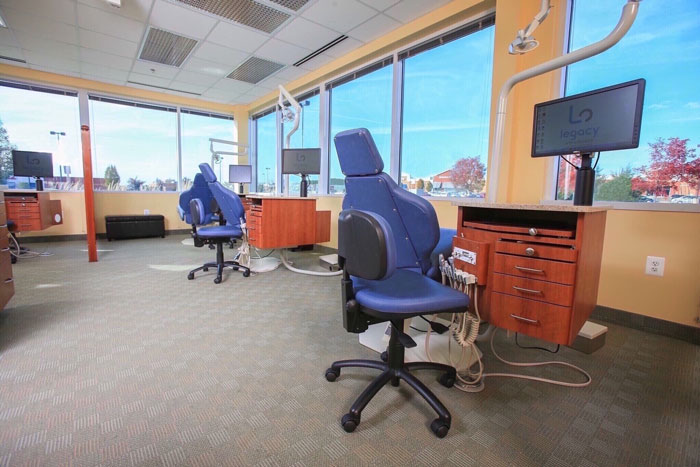8 Easy Facts About Legacy Orthodontics Explained
8 Easy Facts About Legacy Orthodontics Explained
Blog Article
Not known Factual Statements About Legacy Orthodontics
Table of ContentsThe Ultimate Guide To Legacy OrthodonticsAn Unbiased View of Legacy OrthodonticsThe smart Trick of Legacy Orthodontics That Nobody is DiscussingSome Of Legacy OrthodonticsThe Basic Principles Of Legacy Orthodontics
In addition, we offer adjustable therapy routines, adaptable repayment options and an enjoyable, delightful experience.An orthodontist is a dentist educated to identify, avoid, and treat teeth and jaw irregularities. They deal with existing problems and are trained to recognize issues that may create in the future. Orthodontists collaborate with people of every ages, from youngsters to adults. Individuals commonly associate a best smile with health.
Malocclusion, or misaligned teeth, can lead to dental issues, including tooth decay, gum tissue disease, and challenging or excruciating chewing. Not everybody is birthed with straight teeth. If you have a negative bite or big areas between your teeth, you may desire to speak with a dental expert concentrating on orthodontic care.
Legacy Orthodontics Things To Know Before You Buy
( Picture Credit Scores: DigitalVision/Getty Images) Orthodontists utilize repaired and removable oral devices, like braces, retainers, and bands, to transform the setting of teeth in your mouth. Orthodontic therapy is for oral abnormalities, consisting of: Uneven teethBite problems, like an overbite or an underbiteCrowded teeth or teeth that are also much apartJaw misalignmentThe objective of orthodontic therapy is to improve your bite.
A healthy bite guarantees you can eat, eat, and speak appropriately. While you could consider orthodontists as mostly for youngsters or young adults who need dental braces, they can fix dental issues at any age. Orthodontists go to university, oral school, and orthodontic school. After graduation, they invest 2 or 3 years in an orthodontic residency program.
All orthodontists are dental experts, yet not all dentists are orthodontists. Orthodontic residency programs provide intensive, concentrated guideline for dental professionals. They concentrate on two areas: Exactly how to properly and safely relocate teeth How to properly lead development in the teeth, jaw, and faceOnce an orthodontist has completed training, they have the option to become board certified.
Some Known Incorrect Statements About Legacy Orthodontics
Imbalance, or malocclusion, is the most usual reason people see an orthodontist. It is genetic and is the outcome of dimension distinctions in between the top and reduced jaw or in between the jaw and teeth. Malocclusion leads to tooth overcrowding, a misshapen jaw, or uneven bite patterns. Malocclusion is generally treated with: Your orthodontist affixes metal, ceramic, or plastic square bonds to your teeth.
If you have only minor malocclusion, you might be able to utilize clear braces, called aligners, rather than typical dental braces (https://www.domestika.org/en/brianmccune20176). Some individuals require a headwear to help relocate teeth right into line with stress from outside the mouth. After dental braces or aligners, you'll need to use a retainer. A retainer is a customized device that maintains your teeth in position.
They're most usually made use of on children. They can develop extra area in the mouth without having to pull teeth. If you have a major underbite or overbite, you may require orthognathic surgery (additionally called orthodontic surgical treatment) to extend or shorten your jaw. Orthodontists make use of wires, medical screws, or plates to support your jaw bone.
You might need to see an orthodontist if you have: Crowding or not sufficient area for all of your teethOverbite, when your upper teeth come your base teethUnderbite, when your base teeth are as well much forwardSpacing or concerns with gapsCrossbite, which is when your top teeth fit behind your bottom teeth when your mouth is closedOpen bite or an upright void between your front bottom and upper teethMisplaced midline, when the facility of your base and top teeth do not line up Correcting an oral malocclusion can: Make biting, eating, and speaking easierImprove the proportion of our face and your overall appearanceEase discomfort from temporomandibular joint conditionsDifferent your teeth and make them easier to clean, assisting stop dental caries or dental caries It's often a dental practitioner who initially notices Resources misaligned teeth throughout a regular exam.
4 Easy Facts About Legacy Orthodontics Explained

Throughout your initial orthodontic consultation, you'll likely have: An oral examPhotos taken of your face and smileDental X-raysPanoramic (360 degree) X-rays of your face and headImpressions to produce mold and mildews of your teethThese examinations will assist your orthodontist know how to wage your treatment. clear braces. An orthodontist is a dentist that's had training to treat your teeth and jaw
An orthodontist is focused on your bite, so something like a damaged tooth would certainly be dealt with by a dental expert. Orthodontists are focused on your bite, or the method your teeth fit with each other, and the straightness of your teeth.
Ever asked yourself how celebs always appear to have perfectly straightened teeth? Orthodontists are dental specialists who concentrate on dealing with irregularities in the teeth and jaws.
See This Report on Legacy Orthodontics

, orthodontists have a diverse toolkit at their disposal. These tried-and-true braces utilize a system of brackets adhered to the teeth and linked by wires.
Clear aligners, like Invisalign, are a popular option for clients looking for an extra very discreet treatment option. These detachable trays are personalized to gradually shift the teeth's placement. Headgear may be used along with braces or aligners to apply additional targeted pressures, especially for correcting jaw disparities. In situations of narrow jaws, palatal expanders can be made use of to produce room for correct tooth placement.
Report this page